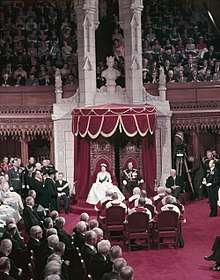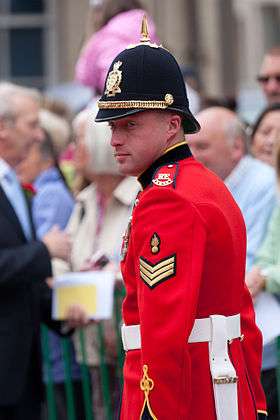Full dress uniform
.jpg)
| Part of a series on |
| Western dress codes and corresponding attires |
|---|
 |
|
Supplementary
|
|
Legend: |
Full dress uniform is the most formal military uniform reserved for parade or other ceremonial or formal occasions. Prior to World War I (1914–18) most armies of the world retained uniforms of this type that were usually more colorful and elaborate than the ordinary duty ("undress") or the increasingly drab active service ("field") uniforms.[1]
History

The British and United States armies were dependent upon voluntary recruiting and found that a smart dress served to attract recruits and improve morale amongst those already serving. The British regimental system fostered numerous distinctions amongst different units.
Even the mainly conscript armies of continental Europe retained many of the colourful features that had evolved during the nineteenth century, for reasons of national and unit pride. Thus, in 1913 most French soldiers wore red trousers and kepis as part of their full dress,[2] the majority of British foot regiments retained scarlet tunics for parade and off duty ("walking out"),[3] the German Army was characterised by Prussian blue,[4] the Russian by dark green,[5] and the Austro-Hungary Army by a wide range of differing facing colours dating back to the 18th century.[6]
There were usually exceptions to each of these rules, often distinguishing elite units. Thus German cuirassiers wore white full dress, British rifle regiments a very dark green known as rifle green, French mountain troops large berets and light blue trousers and so on. The U.S. Army with its smart but relatively sober "dress blues" was an exception, with cavalry, artillery and infantry being distinguished only by the different branch colors.[7]
After World War I most full dress uniforms disappeared. Many of the Imperial or Royal regimes that had taken a particular pride in the retention of colorful traditional uniforms had been overthrown and their republican, fascist, or communist successors had little incentive to retain old glories. Elsewhere cost and disillusion with the "peacock" aspects of old fashioned soldiering had a similar effect, except for ceremonial guard units and such limited exceptions as officers' evening or off-duty uniforms.[8]
Modern armies are characterised by simple and drably coloured dress even for ceremonial occasion, with the exceptions noted above. However a general trend towards replacing conscript armies with long serving professionals has had, as a side effect, a reversion to dress uniforms that combine smartness with some traditional features. Thus the U.S. Army announced in 2006 that uniforms of modern cut but in the traditional dark and light blue colours will become universal issue, replacing the previous grey/green service dress. The French Army has, with the abolition of conscription, reintroduced kepis, fringed epaulettes and sashes in traditional colours to wear with camouflage "trellis" or light beige parade dress.[9] The British Army with its strong regimental traditions has retained a wide range of special features and dress items to distinguish individual units, in spite of recent amalgamations.[10] Although there still exist official patterns for full dress uniforms for each regiment or corps within the British Army, this uniform is seldom issued at public expense, except for units which are often on public duties, such as the Guards Division, Regimental Bands and Corps of Drums, which are bought from the Regiment's allowance.[11]
See also
| Wikimedia Commons has media related to Full dress uniforms. |
References
- ↑ Carman, W.Y. A Dictionary of Military Uniforms. p. 61. ISBN 0-684-15130-8.
- ↑ Jouineau, Andre. French Army in 1914. pp. 7–59. ISBN 978-2-35250-104-6.
- ↑ Harrington, Peter. British Army Uniforms in Color. pp. 10–146. ISBN 0-7643-1302-9.
- ↑ Becker, Carl. The Kaiser's Army in Color. pp. 11–14. ISBN 0-7643-1173-5.
- ↑ Kennedy, Robert W. Uniforms of Imperial & Soviet Russia. pp. 8–27. ISBN 0-7643-1320-7.
- ↑ James Lucas, "Fighting Troops of the Austro-Hungarian Army 1868-1914, ISBN 0-87052-362-7
- ↑ Encyclopædia Britannica, Eleventh Edition, Volume XXVII, pages 592-593
- ↑ Mollo, John. Military Fashion. p. 231. ISBN 0-214-65349-8.
- ↑ Galliac, Paul. L' Armee Francaise. pp. 89–90. ISBN 978-2-35250-195-4.
- ↑ Section 01.200, Army Dress Regulations (All Ranks), Ministry of Defence, January 2011
- ↑ British Army Dress Committee (August 2005). Joint Service Publication 336: The Defence Supply Chain Manual. Vol. 12, Part 3, Pamphlet 12, Sect. 1 (3rd ed.). p. Para. 117, 119.